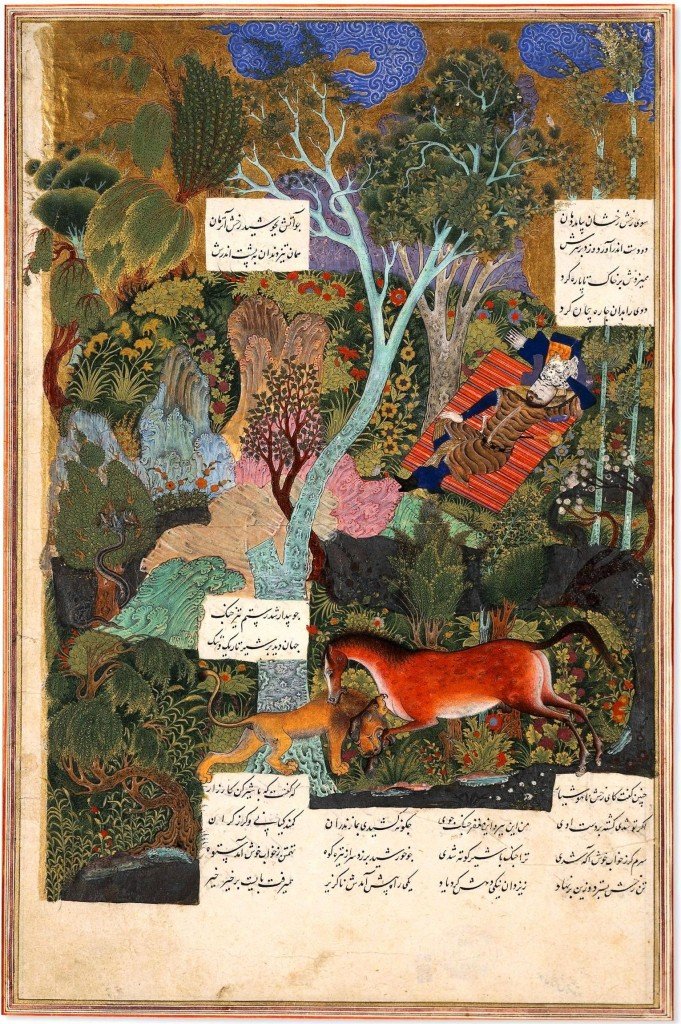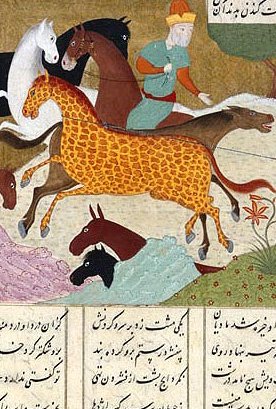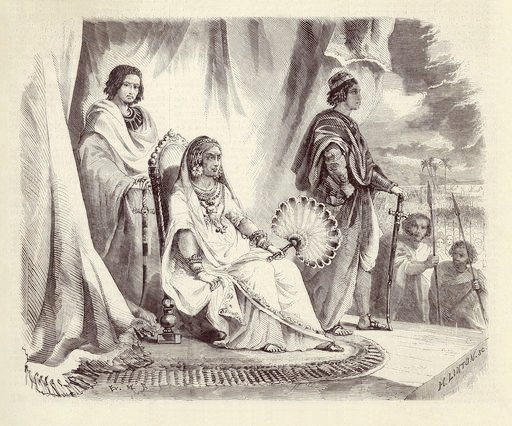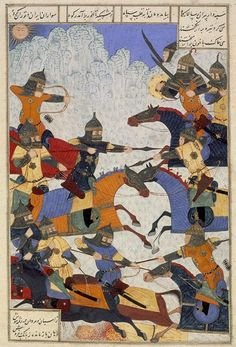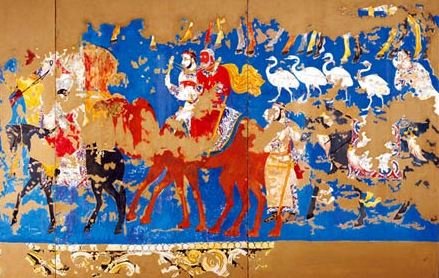Join Tessa Gratton and me as we read the Shahnameh by Abolqasem Ferdowsi. We’re using the Dick Davis translation (Penguin Classics).
Today’s portion: Kay Kavus’s War Against the Demons of Mazanderan
Synopsis:
“In which Kay Kavus becomes convinced that he is more powerful and awesome than even Jashid and Feraydun, attacks the demon homeland, and he and his entire army are literally blinded by his arrogance.”

Poster for the Telugu film Baahubali: The Beginning, showing five of the main characters including the young Baahubali, center forefront, and to his right, his wise and canny royal aunt who saves his life.
TG: Not a lot of surprises in this section. Everybody by now should know what to expect from the moment the first lines open warning us about bad seeds taking over from their father kings. Once Kavus declares himself greater than the great warrior-kings who have come before him, we know he’s doomed, it’s only a matter of how.
I’m a little confused still about what demons are – I can’t tell if they’re all supernatural beings (some of them have to be, throughout the story), but sometimes they seem to be humans who use dark magic and follow Ahriman, not God. That they are mortal, with cities the Persians can travel to and kings and women and children speaks to them being sorcerers, not supernatural creatures.
The counselors certainly can tell a demon when they see one, though, despite the fact that I assumed the first demon, the one who tempted Kavus to invade Mazanderan, was in disguise. Kavas’s counselors knew right away he was talking about attacking the demon homeland, and it’s a wonder the demon was allowed to play at all, if they knew what he was.
(Kavus, of course, would have assumed himself to be too great to be tempted, so I can see him allowing a demon to play music in his court. He’d think he was immune.)
I thought it was pretty funny that Kavus either wants to destroy all the demons…. or tax them heavily, and poor Zal!!! I get the feeling Zal just wants to be left alone, but god, ok, fine, he’ll help out because it’s the right thing to do.
Very much looking forward to the next section of Rostam’s seven trials. You know he’s a hero because he has trials.

Kay Kavus chained in a cave, guarded by “the white demon” is basically a dude with an animal head that looks part bull and part cat? to me, kind of. I don’t know.
KE: Yes, indeed. Heroes will have trials. In fact, now that I think about it, that makes me want to write a story about a heroine having trials.
My thoughts: a demon trouble maker sets up this war! I have to think this was not done with the knowledge and consent of the demon king because the king does not react until he is attacked. I also can’t quite tell if the demons are bad by nature, supernatural, or just sorcerers. What they are is not the same as humans, somehow. Also I noted how the demon king’s heart is filled with pain when he hears news of the war devastating his subjects.
In some ways this reminds me of Jewish stories about demons, who are otherly natured people who have some supernatural aspect but who are not explicitly evil. In fact, there are Jewish demons who believe in G-d and follow the mitzvot and pray just as other Jews do.
Quotes:
“he wastes the wealth he took no pains to accumulate” and “Kavus is an arrogant man who has not experienced the heat and cold of this world” both remind me of our own economic inequality landscape, not to mention the current election in the USA. People who think that by being born into wealth they somehow have inherited greater worthiness. There are so many stories, both fictional and historical, of the inheritors of wealth and rulership squandering that which their forefathers (usually) created or built. They demand the privilege that’s already shown them. So it’s interesting to see what Zal says to Kavus (that he hopes never to hear Kavus bewail his misfortune and bad decisionmaking), and then of course that is EXACTLY what happens because this is in part a story of the fall of the mighty.
Also it is interesting to me how much of the story is taken up with council meetings, more than battles.
My favorite phrase:
“it was a place that even elephants feared.”
Finally, on the related but not quite analogous subject of usurpers who have taken the throne from a rightful heir, I urge every person to check out the Telugu film BAAHUBALI: THE BEGINNING (photo above) which is epic fantasy at its finest. There is good, there is evil, there are four major women characters (although they never talk to each other, but I’ll take what I can get), and it also reflects that element we have discussed in reference to Zal in which the hierarchy is set as by the gods, so that even a clearly superior prince like Zal will never try to usurp the line of Feraydun. One of the characters in Baahubali is a great warrior who serves a king he knows is unjust, because “you are the king and we are your slaves.”
Here’s the trailer:
#
Next week: Rostam’s seven trials!
Previously: Introduction, The First Kings, The Demon King Zahhak, Feraydun and His Three Sons, The Story of Iraj, The Vengeance of Manuchehr, Sam & The Simorgh, The Tale of Zal and Rudabeh, Rostam, the Son of Zal-Dastan, The Beginning of the War Between Iran and Turan, Rostam and His Horse Rakhsh, Rostam and Kay Qobad



